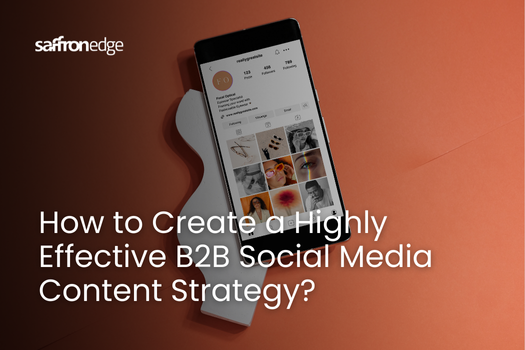Contents
Are your social media efforts bringing in the right audience, or are you just posting content without seeing real engagement?
In the competitive world of B2B marketing, social media is more than just a presence—it’s a strategic tool that can drive leads, establish thought leadership, and enhance brand authority.
However, simply being on social media isn’t enough. A well-crafted B2B social media content strategy requires careful planning, consistency, and a deep understanding of your target audience.
The significance of social media in B2B marketing is underscored by the fact that, as of 2025, there are approximately 5.17 billion social media users worldwide, with 320 million new users joining between January 2024 and January 2025.
In this blog, we will explain the steps to creating a successful B2B social media content strategy that drives engagement, builds brand authority, and contributes to business growth.
What is a B2B Social Media Content Strategy
A B2B social media content strategy is a structured approach to creating and sharing content that engages business audiences, builds credibility, and drives lead generation. Unlike B2C, which focuses on direct sales and entertainment, B2B social media content revolves around thought leadership, industry insights, and relationship-building.
It requires a deep understanding of the target audience, their pain points, and how your business can provide value through informative and solution-driven content.
To succeed, businesses should prioritize platforms like LinkedIn, Twitter, and YouTube, where decision-makers actively seek industry trends and expertise. A strong strategy includes educational blog posts, case studies, webinars, and engaging discussions to nurture leads through the sales funnel.
Consistency, data-driven optimization, and audience engagement are key to ensuring long-term success in B2B social media marketing.
Understanding Your Target Audience for B2B Social Media
The first step in creating a B2B social media content strategy is to deeply understand your audience and how social media marketing influences their decision-making process.
Unlike B2C marketing, where the audience is individual consumers, B2B marketing targets professionals, businesses, and decision-makers.
Steps to Identify Your Audience:
-
Create Buyer Personas: Define your ideal customers based on industry, job roles, company size, pain points, and needs.
-
Analyze Existing Customers: Look at your current customer base and identify common characteristics.
-
Use Analytics Tools: Leverage tools like Google Analytics, LinkedIn Insights, and other social media analytics to gather demographic and behavioural data.
-
Monitor Competitors: Observe the content that resonates with their audience to refine your approach.
Choosing the Right Social Media Platforms
Not all social media platforms are suitable for B2B marketing. Your strategy should focus on platforms where your audience is most active and engaged.
LinkedIn is the premier platform for professionals. It’s designed for LinkedIn marketing, networking, sharing industry insights, and building relationships with decision-makers.
-
Thought Leadership: Share articles, white papers, and insights to establish your brand as an authority in your industry.
-
Networking: Connect with industry professionals, join groups related to your field, and engage with content relevant to your business.
-
Lead Generation: Utilize LinkedIn Ads, sponsored content, and InMail to reach a targeted professional audience. LinkedIn’s powerful targeting options allow you to focus on specific job roles, industries, and companies.
Twitter (X)
Twitter, now known as X, is excellent for Twitter marketing, real-time updates, industry news, and engaging with thought leaders.
-
Industry News: Share and comment on your industry's latest trends, news, and insights.
-
Quick Updates: Promote blog posts, product updates, or upcoming webinars.
-
Engagement: Participate in industry-related Twitter chats, follow influencers, and engage in conversations. Use relevant hashtags to increase visibility.
Although Facebook is traditionally a B2C platform, Facebook marketing can be valuable for B2B marketing through specific strategies.
-
Facebook Groups: Join or create groups related to your industry to network, share content, and foster a community around your brand.
-
Facebook Ads: Facebook’s robust advertising platform allows precise targeting, including by job title, interests, and company. This makes it possible to reach decision-makers with relevant content.
Instagram is often viewed as a B2C platform, but it’s also effective for B2B when used for visual storytelling and branding.
-
Visual Content: Showcase behind-the-scenes content, company culture, and product development. Use Stories and Reels to highlight day-to-day operations and events.
-
Employer Branding: Attract talent by sharing employee stories, workplace highlights, and company achievements.
-
Customer Testimonials: Share case studies or client success stories with visually appealing graphics.
YouTube
YouTube is a powerful platform for YouTube video marketing, especially for educational purposes and detailed product demonstrations.
-
Webinars and Tutorials: Host webinars, product demos, and how-to videos that provide value to your audience.
-
Thought Leadership: Create video content featuring industry experts, interviews, and panel discussions.
-
Brand Authority: Share client testimonials, case studies, and behind-the-scenes videos to establish authority in your industry.
TikTok
TikTok is an emerging platform for B2B marketers looking to connect with a younger, more creative audience. It allows brands to showcase their personality and share informal, engaging content.
-
Creative Content: Share short, engaging videos that highlight your company’s culture, quick tips, or product features.
-
Industry Trends: Participate in trending challenges and use popular sounds to gain visibility.
-
Employer Branding: Highlight your company’s fun side to attract young talent and foster a sense of community.
Boost Your B2B Success with Targeted Social Media Marketing
Drive engagement, generate leads, and establish your brand authority with our data-driven social media strategies.
7 Key Strategies to Plan B2B Content for Social Media
Once your goals are set, it's time to develop a structured content marketing plan that aligns with your audience’s needs and business objectives.
Educational Content
Educational content is designed to provide valuable insights, knowledge, and solutions to your audience’s problems. It helps establish your brand as a thought leader in your industry.
-
Whitepapers: In-depth reports that explore industry challenges and solutions backed by research.
-
Case Studies: Real-world examples showcasing how your product or service helped a client overcome challenges.
-
How-To Guides: Step-by-step instructions to solve specific industry-related problems.
Industry News and Trends
Sharing updates on industry news, trends, and insights keeps your audience informed and engaged.
-
Posting about recent industry developments or changes in regulations.
-
Providing expert opinions on emerging trends and their impact.
-
Summarizing key takeaways from industry reports and conferences.
User-Generated Content (UGC)
User-generated content is content created by customers, employees, or other stakeholders that showcases their experiences with your brand.
-
Customer Testimonials: Quotes or video reviews from satisfied customers.
-
Success Stories: Case studies or social media posts highlighting positive client experiences.
-
Employee Advocacy: Employees sharing their experiences working at your company.
Behind-the-Scenes Content
This content gives a human touch to your brand by showcasing company culture, operations, and daily activities.
-
A day in the life of your team.
-
Photos and videos of your workplace or company events.
-
Employee spotlights highlighting team members and their roles.
Video Content
Videos are a powerful tool for storytelling, education, and engagement.
-
Webinars: Live or recorded sessions that educate and interact with your audience.
-
Interviews: Conversations with industry leaders, company executives, or satisfied customers.
-
Product Demos: Walkthroughs showcasing how your product or service works.
Infographics
Infographics simplify complex information and present it in an easy-to-understand, visually appealing format.
-
Statistics and key data points are presented in a graphical format.
-
Step-by-step guides are visually broken down for clarity.
-
Comparisons between different solutions or approaches.
Interactive Content
Interactive content encourages audience participation, making your brand more engaging.
-
Polls and Surveys: Ask your audience about their opinions or preferences.
-
Q&A Sessions: Live or pre-recorded sessions where you answer industry-related questions.
-
Live Sessions: Host real-time discussions, training sessions, or product launches.
Creating a Content Calendar for Social Media
A well-structured content calendar is essential for maintaining consistency and efficiency in content distribution. It helps businesses plan, schedule, and manage their content effectively, ensuring that their marketing efforts align with business goals and audience engagement.
A content calendar allows you to:
-
Maintain a consistent posting schedule
-
Ensure a balanced mix of content types
-
Streamline workflow and collaboration
-
Align content with key industry events
-
Track performance and make necessary adjustments
Determine Posting Frequency
Posting too frequently may overwhelm your audience while posting too infrequently can make your brand seem inactive. A well-planned posting frequency ensures you stay visible without spamming your audience.
How to Do It:
-
Decide how often you will post on each social media platform.
-
Consider your audience’s engagement patterns—some platforms require more frequent updates (e.g., Twitter), while others work well with less frequent but high-quality content (e.g., LinkedIn, YouTube).
-
Start with a manageable schedule and adjust based on engagement and resource availability.
Example Posting Frequency for B2B Social Media:
-
LinkedIn: 3–5 posts per week (industry insights, case studies, thought leadership).
-
Twitter (X): 5–10 tweets per week (news updates, conversations, brand engagement).
-
Facebook: 2–4 posts per week (community engagement, behind-the-scenes content).
-
Instagram: 3–5 posts per week (visual storytelling, company culture, product highlights).
-
YouTube: 2–4 videos per month (webinars, product demos, interviews).
Balance Content Types
A good content strategy is diverse, ensuring that your audience receives a mix of educational, promotional, and engaging content. If your content is too sales-focused, it may turn potential customers away.
How to Do It:
-
Educational Content (40-50%): Whitepapers, case studies, how-to guides, webinars.
-
Promotional Content (20-30%): Product updates, testimonials, special offers.
-
Engagement-Driven Content (20-30%): Polls, Q&As, user-generated content, interactive posts.
Using a structured approach like the 80/20 rule (80% informative, 20% promotional) ensures your audience finds value in your content without feeling pressured to buy.
Leverage Scheduling Tools
Manually posting content across multiple platforms can be time-consuming and inefficient. Scheduling tools automate posting, ensuring content is published at the best times for engagement.
How to Do It:
-
Use social media management tools like Hootsuite, Buffer, Sprout Social, HubSpot, or Later to schedule posts in advance.
-
Set up automated posting to maintain consistency, even when your team is busy.
-
Analyze the best posting times for each platform to maximize reach and engagement.
Example:
A marketing team can schedule a month’s worth of LinkedIn posts in one sitting, ensuring consistency while freeing up time for other strategic initiatives.
Plan Around Industry Events
Aligning content with major industry events, product launches, or trending topics increases relevance and engagement. Businesses that capitalize on industry trends can position themselves as thought leaders.
How to Do It:
-
Research and note key industry events, trade shows, product launches, and global observances related to your field.
-
Create content that aligns with these events, such as event previews, live coverage, or post-event analysis.
-
Use trending hashtags and keywords to improve visibility.
Example:
If you're in the tech industry, you might create content around major events like CES, Web Summit, or Google I/O to provide insights or reactions to new trends.
Monitor and Adjust
A content calendar should not be static. Tracking content performance helps businesses understand what works and what doesn’t, allowing continuous improvement.
How to Do It:
-
Use analytics tools like Google Analytics, LinkedIn Analytics, and Meta Insights to track engagement, reach, and conversions.
-
Identify high-performing content and create similar types of posts.
-
Adjust posting frequency, timing, and content types based on audience feedback and engagement metrics.
Example:
If a company notices that its LinkedIn thought leadership posts get more engagement than promotional posts, it may shift its strategy to focus more on insights and industry news.
Leveraging Paid Social Media Strategies
While organic reach is essential, paid marketing can amplify your efforts and reach a highly targeted audience.
-
LinkedIn Ads: Sponsored posts, lead generation forms, and InMail campaigns.
-
Facebook & Instagram Ads: Retargeting, carousel ads, and brand awareness campaigns.
-
Twitter (X) Ads: Promoted tweets and Twitter Lead Generation Cards.
-
YouTube Ads: Video advertising for brand awareness and lead generation.
-
Retargeting Campaigns: Re-engage website visitors and potential leads.
Tracking performance is critical to understanding what works and what needs improvement.
Key Metrics to Track:
-
Engagement Rate: Likes, shares, comments, and interactions.
-
Click-Through Rate (CTR): Percentage of users who click on your links.
-
Conversion Rate: Leads or sales generated from social media.
-
Follower Growth: Increase in audience size over time.
-
Website Traffic: Visits driven from social media platforms.
Conclusion
Creating an effective B2B social media content strategy requires deeply understanding your audience, choosing the right platforms, setting clear goals, and consistently delivering valuable content.
Saffron Edge is a leading SEO agency specialising in data-driven strategies, targeted advertising, and content creation to help businesses maximize their social media potential.
Start building your B2B social media strategy today with expert guidance and position your brand for long-term growth!
Get The Ultimate Marketing Toolkit
Frequently Asked Questions
What is the best social media platform for B2B marketing
LinkedIn is the most effective platform for B2B marketing, as it facilitates networking, thought leadership, and lead generation.
How often should B2B companies post on social media?
Posting frequency varies, but businesses should aim for at least 3-5 times a week to maintain engagement and visibility.
What type of content works best for B2B social media?
Educational content, case studies, industry news, and video content tend to perform well in the B2B space.
How can B2B companies measure social media success?
Key metrics include engagement, lead generation, website traffic, and conversion rates.
Why should B2B companies invest in paid social media?
Paid advertising helps reach a highly targeted audience, increasing brand awareness and lead generation.
Maximize Your B2B Social Media Impact
Unlock the power of strategic social media marketing to drive engagement, generate leads, and establish industry authority. Let us create a tailored strategy that delivers results.
Related Blogs
We explore and publish the latest & most underrated content before it becomes a trend.

Subscribe to Saffron Edge Newsletter!

Get The Ultimate Marketing Toolkit










